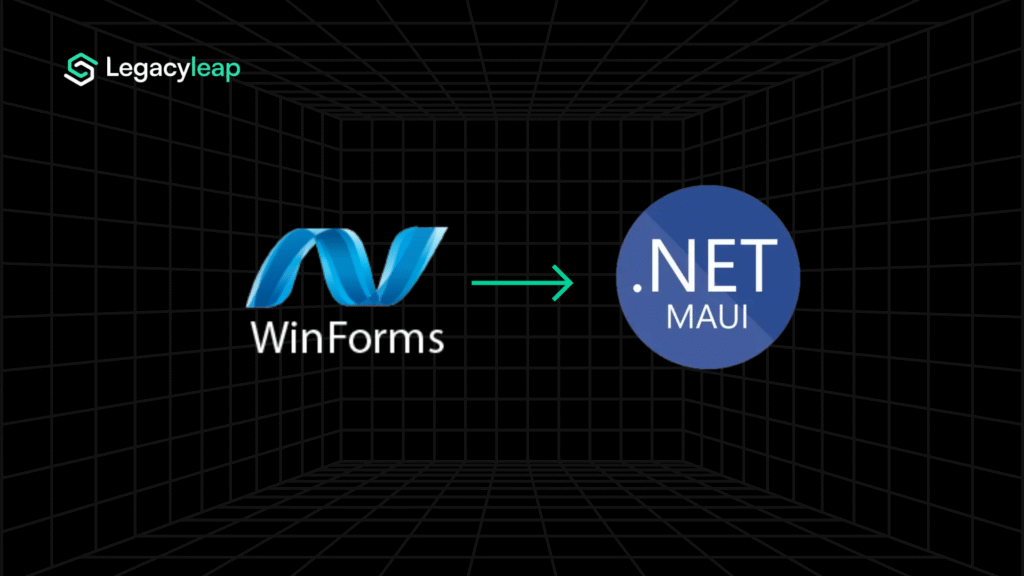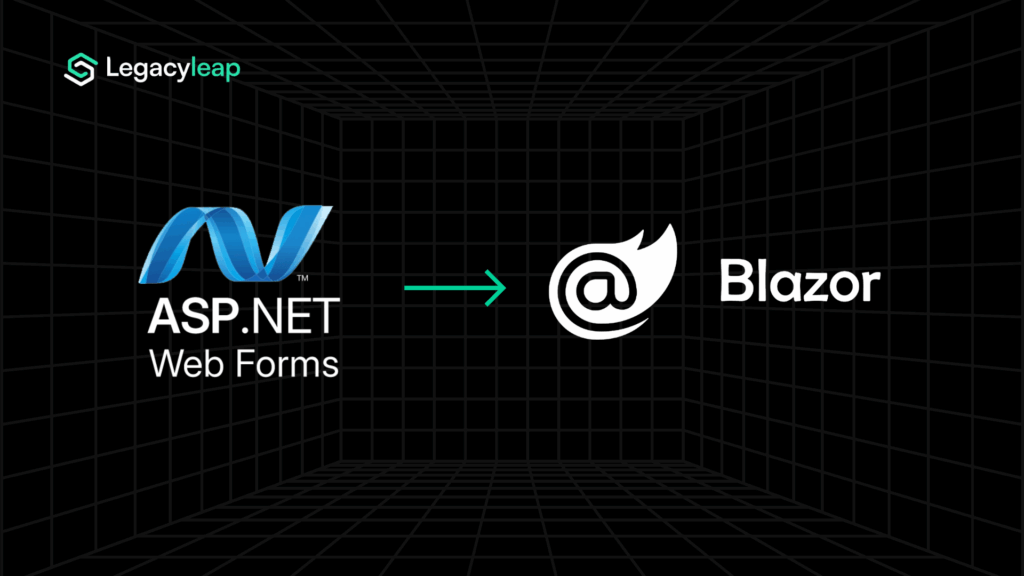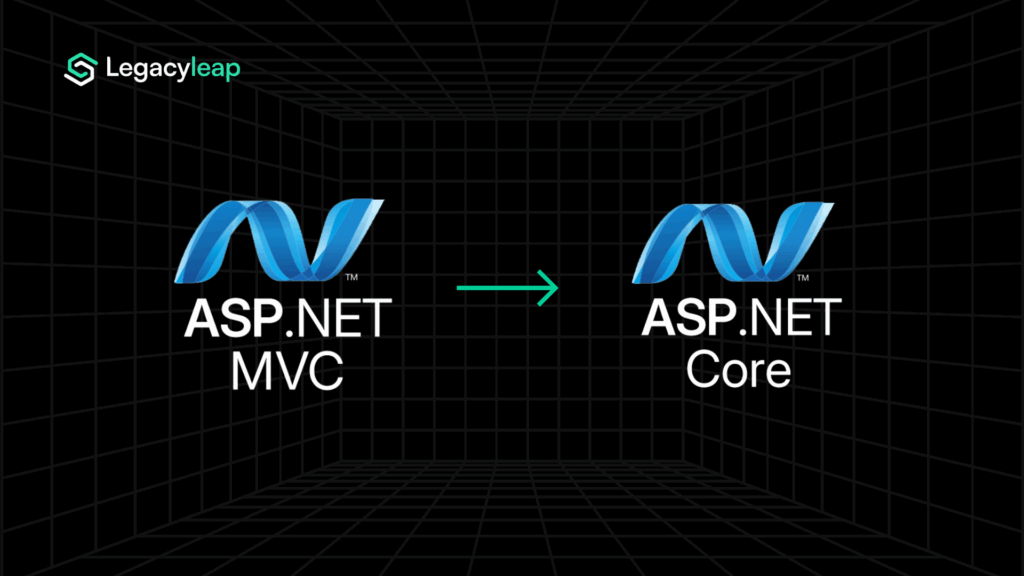Modernizing legacy systems with Gen AI opens doors to faster migrations, smarter code analysis, and scalable documentation, all with minimal disruption.
However, data security remains a significant barrier for enterprises. Sensitive business data cannot be handed over to third-party platforms, no matter how advanced the technology. So, how can organizations leverage Gen AI for modernization while safeguarding their data?
The answer lies in AI Middleware. Acting as a secure intermediary, it enables enterprises to harness Gen AI without compromising privacy or compliance.
Middleware isolates sensitive data from external AI platforms, ensuring organizations control where and how their data is processed. Whether using public LLMs like GPT-4 or private models within firewalls, middleware ensures seamless integration while prioritizing data governance.
This blog explores how AI Middleware underpins Legacyleap’s approach to modernization and breaks down how it transforms Gen AI into a trusted, enterprise-grade modernization tool.
What is AI Middleware?
AI middleware is a crucial component in modernizing enterprise systems with Gen AI. It acts as an abstraction layer that securely connects AI-driven automation tools (agents) with various large language models (LLMs).
This intermediary layer ensures that the agents do not directly interact with the LLMs, maintaining a clean separation that safeguards sensitive data and promotes secure communication between systems.
Design and purpose
At its core, the design of AI middleware facilitates seamless interaction with multiple LLMs without compromising data privacy.
Isolating the enterprise data from external AI platforms ensures that sensitive information remains secure while enabling powerful AI-driven capabilities.
Flexibility in LLM configurations
AI middleware is highly flexible and capable of integrating with various types of LLMs depending on the enterprise’s needs. It supports:
- Publicly Hosted LLMs: Accessible, cloud-based models like GPT-4 or similar offerings that are available through platforms such as OpenAI.
- Privately Hosted Enterprise LLMs: Models securely hosted within the enterprise firewall to ensure full control over the data.
- Cloud-Native LLMs: Integration with services like AWS Bedrock, which offer hosted LLMs optimized for enterprise use.
This versatility allows middleware to manage a wide range of models, including popular ones like Llama 2, Code Llama, Mistral, Starcoder, and even custom, enterprise-specific solutions.
The result is a unified, secure interface that bridges AI capabilities with business applications in a seamless, scalable way.
Addressing enterprise needs with AI Middleware
In enterprise modernization, AI middleware plays a pivotal role in aligning Gen AI tools with the specific needs of businesses. It provides a customizable, secure, and compliant framework that addresses two key concerns for enterprises: security and customization.
Security compliance
Security remains a top priority for enterprises, especially when dealing with sensitive data. Many organizations face strict policies around data privacy, particularly when interacting with external AI platforms.
Middleware is designed to ensure that all AI-driven operations remain within the enterprise’s control. It safeguards against the risk of sharing sensitive or confidential data with public LLMs like GPT-4 or Amazon Titan by keeping interactions isolated within private, enterprise-controlled environments.
Customization capabilities
AI middleware offers extensive flexibility, enabling enterprises to adapt the system to their unique requirements. If an organization has proprietary internal models, the middleware can be adjusted to connect seamlessly with these models. This capability is critical for businesses that rely on specialized, in-house AI systems rather than public LLMs.
Furthermore, middleware supports prompt engineering, allowing enterprises to fine-tune the interaction between AI models and the data being processed. Built-in experimentation tools facilitate this process, enabling companies to adjust the middleware and optimize LLM performance for specific business needs.
Whether it’s tweaking an existing model or creating new interactions, middleware ensures businesses can customize their setup without compromising on security or efficiency.
With these advanced security measures in place, enterprises can confidently leverage the power of Gen AI for modernization without fear of non-compliance or data breaches.
Middleware in the deployment architecture
One of the standout features of AI middleware is its deployment flexibility, ensuring that enterprises can integrate AI capabilities in a way that suits their infrastructure and operational requirements.
As part of the larger Legacyleap platform, middleware can be deployed directly within a customer’s environment, offering seamless integration while maintaining full control over data and processes.

Deployment modes
AI middleware supports multiple deployment configurations, allowing organizations to choose the mode that best fits their needs and scale:
- Lean PoC Mode: Ideal for smaller, resource-efficient setups, this mode enables enterprises to quickly test and validate AI-driven modernization solutions with minimal overhead.
- Scalable Mode: Designed for larger enterprises, this mode supports high-scale deployments that can manage multiple developers, teams, and applications working simultaneously. It ensures that as organizations grow and expand their AI usage, the middleware remains effective without compromising performance or security.
Deployment options
Middleware can be deployed in various environments to match the organization’s technical architecture.
- Kubernetes: For highly scalable, containerized applications, the middleware can be deployed on Kubernetes clusters (e.g., EKS) to provide automatic scaling and efficient resource management.
- On-Premise/Virtual Machines: For enterprises that prefer to keep their infrastructure in-house, middleware can be deployed on virtual machines, whether on AWS EC2, GCP instances, or traditional on-premise servers.
Requirements and prerequisites
The middleware is bundled as part of the comprehensive Legacyleap platform, including all the AI logic and model-hosting servers needed for seamless integration. To get started, the following basic software requirements must be met:
- Docker: For containerization and ease of deployment across different environments.
- Python & Java: Standard programming environments necessary for AI model hosting and logic integration.
This flexibility in deployment ensures that middleware can be seamlessly integrated into any enterprise ecosystem, adapting to various cloud, on-premise, and hybrid infrastructures, while remaining robust enough to handle enterprise-scale operations.
Middleware’s role in modernization use cases
AI middleware plays an integral role in modernizing legacy systems using Gen AI. It drives the seamless integration of AI-powered solutions within enterprise architectures, ensuring a smooth and continuous modernization process.
Integration with LLMs
The strength of AI middleware lies in its ability to connect and optimize multiple LLMs for different enterprise needs. Whether using public models like GPT-4 or private models hosted securely within the enterprise, middleware ensures smooth interoperability, making it a versatile tool for modernization.
- Optimizing model performance: Middleware provides the flexibility to choose the most suitable LLM for each specific use case, recommending optimal models and configurations based on the enterprise’s goals.
- Adaptability for suboptimal models: When faced with an unsupported or inefficient model, middleware adjusts by fine-tuning prompts or suggesting better alternatives, ensuring businesses always have the right model for their needs.
Real-world application
A prime example of AI middleware’s power in action is the SAP HANA-to-Snowflake migration project we executed for a leading Fortune 500 enterprise. Middleware was essential in managing data flows and AI processes, ensuring a secure, efficient, and scalable transition. But its impact went beyond just data migration—it was pivotal in modernizing the enterprise’s entire infrastructure, enabling the business to leverage Gen AI for greater efficiency and performance.
Middleware also plays a key role in more complex modernization efforts, such as converting SAP OTC modules to modern technologies like Node.js. These real-world use cases demonstrate how AI middleware is already facilitating end-to-end modernization, helping enterprises harness Gen AI to solve real business challenges while prioritizing flexibility, scalability, and security.
Adaptation and tailored solutions
AI middleware is designed to easily adapt to the evolving needs of enterprises as they modernize. With its robust flexibility, it supports a range of configurations, models, and use cases, ensuring that businesses can scale securely while staying aligned with their objectives.
As enterprises integrate new models or adjust their workflows, middleware makes it simple to optimize and fine-tune every aspect of their deployment.
Prompt engineering
When integrating new LLMs, the middleware offers seamless prompt adjustments to optimize performance for specific outcomes. The built-in experimentation tools provide teams with the ability to make quick, data-driven refinements, ensuring each AI model delivers the desired results without disrupting the overall modernization process.
Turnkey customization
The middleware offers turnkey customization capabilities, allowing enterprises to tailor the platform to their unique requirements. Whether it’s integrating proprietary LLMs or addressing specific compliance and data privacy needs, this adaptability ensures that the solution is fully aligned with each enterprise’s technological and regulatory landscape.
By making the platform highly configurable, enterprises can unlock maximum value from their AI-driven modernization efforts, all while maintaining full control over their environments.
Legacyleap’s AI Middleware: The Key to Secure Gen AI-Driven Modernization
Modernization is no longer just about migrating from old to new—it’s about doing so intelligently, securely, and at scale.
AI middleware is one missing piece that enables enterprises to harness Gen AI for modernization without compromising control, security, or compliance. It’s part of an essential framework that ensures AI-driven transformation happens on enterprise terms.
At Legacyleap, we’ve embedded AI middleware into the core of our modernization approach, ensuring businesses can accelerate migrations, optimize applications, and future-proof their tech stacks—all while keeping their most valuable asset, their data, firmly under their control.
So the real question is—how is your enterprise approaching modernization? If Gen AI is part of your roadmap, but security and flexibility remain concerns, it’s time to look at a smarter solution.
Check out our website to explore how Legacyleap is pioneering Gen AI-driven modernization!







